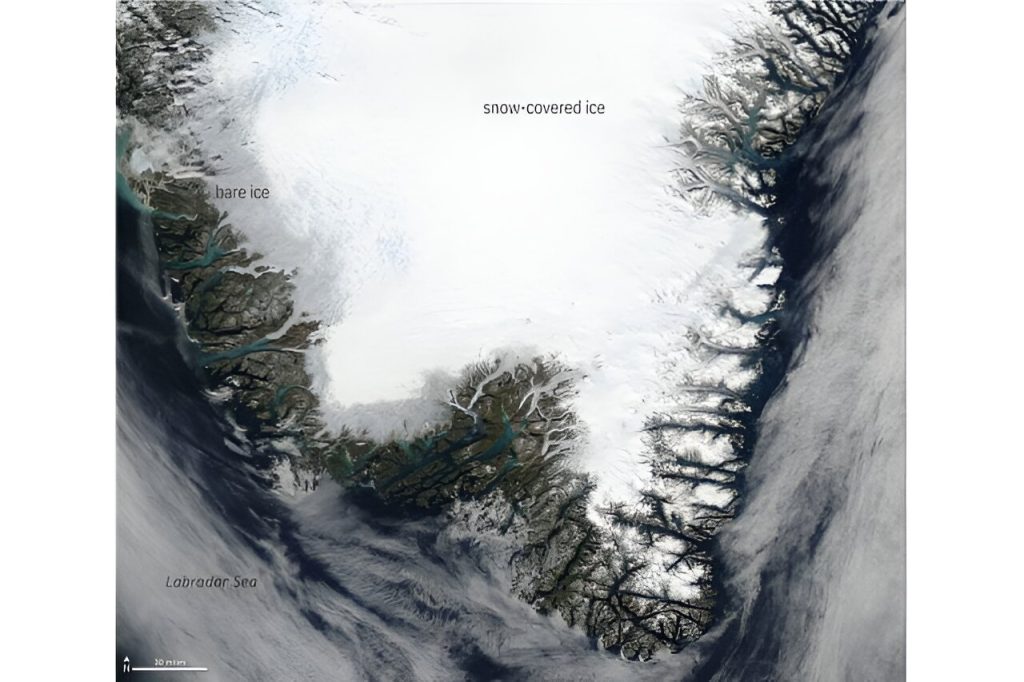A satellite image like this one shows southern Greenland in the afternoon of September 4, 2022. Exposed, dirty ice at the edge of the ice sheet appears gray. Snow-covered ice is bright white. The pale blue ribbons and circles are meltwater lakes, rivers, and ponds. Image credit: NASA Imagery, WorldView
As the Earth continues to warm due to human-induced climate change, accurate computer climate models will play a key role in revealing exactly how the climate will continue to change in the coming years.
In a study published in Journal of Geophysical Research: AtmosphereA team led by researchers from the University of California, Irvine’s Department of Earth System Science and the University of Michigan’s Department of Climate and Space Sciences and Engineering has found that climate models commonly used by geoscientists overestimate a key physical property of Earth’s climate system: albedo – the degree to which ice reflects Planet-warming sunlight back into space.
“The old model found that the ice was about 5 percent too reflective,” said Chloe Clark, project scientist in Professor Charlie Zehnder’s group at the University of California, Irvine. “The ice was just too reflective.”
The amount of sunlight the Earth receives and reflects is important for predicting how much the planet will warm in the future, and a previous version of the model, called the Energy Exascale Earth System Model (E3SM), overestimated albedo because it didn’t take into account what Clark says are microphysical properties of ice in a warming world.
These properties include the effect that things like algae and dust have on the albedo: dark-colored algae and dust can reduce the reflectivity of snow and ice, reducing its ability to reflect sunlight.
To conduct the analysis, Clark and her team Satellite data To track the albedo of the Greenland Ice Sheet, they found that E3SM’s reflectance overestimates the reflectance of the ice sheet, “which means the model is estimating less melting than would be expected from the microphysical properties of the ice,” Clark said.
But when the new ice reflectance is incorporated into the model, it finds that the Greenland Ice Sheet is melting at a rate about 6 gigatonnes faster than in the previous model version, which is based on albedo measurements that are more consistent with satellite observations.
Clark hopes her team’s research highlights the importance of how seemingly small properties can have far-reaching effects on the overall climate. “We think our study will help models do a better job of capturing climate feedbacks related to snow and ice,” she said.
Next, Clark hopes to study different icy parts of the planet to gauge how widespread the albedo discrepancy in E3SM is.
“Our next step is to make this work not just for Greenland but around the world,” Clark said, adding that they also plan to compare the new Greenland ice sheet’s melting rates with observations to gauge how accurate the new estimate is. Albedo “It would be useful to apply this to glaciers in places like the Andes and Alaska.”
Additional authors include Raf Antwerpen (Lamont-Doherty Earth Observatory), Mark G. Flanner (University of Michigan), Adam Schneider (National Oceanic and Atmospheric Administration), Marco Tedesco (Lamont-Doherty Earth Observatory) and Charlie S. Zender (University of California, Irvine).
For more information:
CA Whicker-Clarke et al. “Influence of physically based ice radiative processes on the Greenland ice sheet albedo and surface mass balance in E3SM” Journal of Geophysical Research: Atmosphere (2024). Posted on: 10.1029/2023JD040241
Provided by
University of California, Irvine
Quote: Earth system scientists find missing piece in climate models (July 15, 2024) Retrieved July 15, 2024 from https://phys.org/news/2024-07-earth-scientists-piece-climate.html
This document is subject to copyright. It may not be reproduced without written permission, except for fair dealing for the purposes of personal study or research. The content is provided for informational purposes only.


